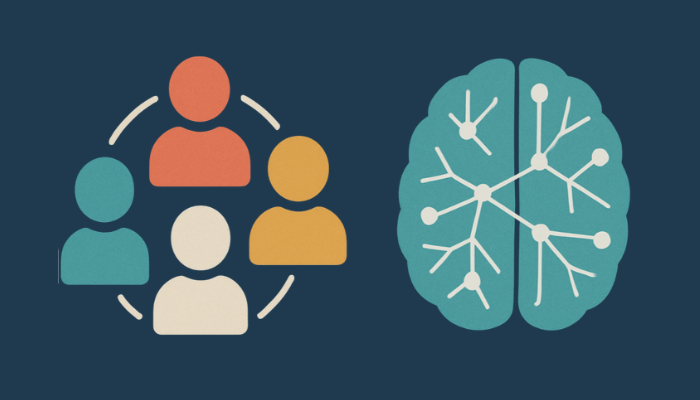
Exploring Culture, Inclusion, and Neuroscience Part 2
10 Keys to More Inclusive and Effective Cross-Cultural Programs If you’ve ever struggled to align global teams or ...

Table of Contents
A few months ago I had the pleasure of attending the SIETAR (Society for Intercultural Education, Training, and Research) conference titled "Building Inclusion through Intercultural Dialogue" held in London.
The following sessions stood out as thought-provoking and deeply relevant to intercultural practitioners and business leaders alike:
“Combatting Ideology Can Be Fun – The Socratic and Other Methods for Dialogue” by Matthew Hill
“Getting Along with ‘Difficult’ People – Fostering Rapport through TRIPS” by Helen Spencer-Oatey
“Why DEI Needs to Be About More Than Identity” by Tanya McCalmon
“Exploring Culture, Inclusion, and Neuroscience” by Robert Gibson
I’ve started unpacking some of these sessions, beginning with Robert Gibson’s workshop on culture, inclusion, and neuroscience.
The speaker, a former cross-cultural specialist at Siemens and author of the book “Bridge the Culture Gaps,” focused on the connections between culture, inclusion, and neuroscience.
In his book, Gibson outlines several business functions where cross-cultural competence significantly enhances effectiveness:
Expanding into new markets requires a deep understanding of cultural differences that influence key business aspects like product development, pricing, messaging, and advertising. Cultural variations significantly impact consumer preferences, requiring businesses to adapt their products, slogans, and user experiences to align with local expectations.
Different cultures have unique expectations regarding job applications, such as what information should be included in a CV. Additionally, global compensation policies must be designed to maintain consistency while respecting regional norms and legal requirements.
Cross-border finance teams must navigate cultural differences in work styles, especially during data collections or audits. In some cultures, employees are more likely to cooperate when they understand the purpose of providing financial data and trust their colleagues. Trust and clarity of purpose are prerequisites for collaboration.
There are additional areas where cross-cultural understanding can enhance the effectiveness of internationally operating teams, and functions that benefit from cross-cultural understanding include:
Employees with intercultural business competence can navigate cultural differences effectively, fostering meaningful relationships across diverse backgrounds for mutual benefit. They are also able to harness diversity as a strategic advantage in a competitive marketplace.
A well-known example is the case of Cavendish bananas, on which much of the world relies. If a fungal disease were to spread, it would lead to a severe shortage.
The business parallel?
This concept applies to business as well. Relying on a homogeneous workforce, targeting a single customer segment, or depending on a limited range of suppliers, or offering only a narrow product offering and services may yield short-term success. However, in an increasingly dynamic and evolving business landscape, such an approach is unsustainable in the long run. Diversity and adaptability are key to resilience and growth.
Based on research by Eisenberger (2012), it was found that the human brain processes social pain and physical pain in the same way. In other words, being excluded activates the same regions of the brain as physical injury — making social rejection neurologically and emotionally real.
This has wide-reaching implications for society as well as for teams. If a member of your team feels the pain of exclusion, their performance will suffer.
Cross-cultural programs play an important role in fostering inclusion among global teams. These initiatives not only help employees understand different working preferences but also encourage them to explore and implement new communication strategies.
Additionally, they provide an opportunity for individuals to gain deeper self-awareness and develop the ability to adapt swiftly to diverse communication styles. By learning about one another, employees cultivate mutual respect, celebrate cultural diversity, and contribute to the creation of an inclusive and collaborative work environment.
These programs promote a growth mindset, where curiosity and collaboration replace judgment and avoidance.
This is a great quote to share that we all need to keep in mind:
“Diversity is a fact; Equity is a choice; Inclusion is an action; Belonging is an outcome”
-Arthur Chan and Robbins
The workshop showed the connection between culture and inclusion, identifying barriers to inclusion, and strategies for cultivating an inclusive workplace.
Neuroscience tells us that our brains constantly filter information through the lens of our cultural backgrounds. We are all biased but it’s important to know what our biases are.
“It’s sometimes surprising how we can change our view of people when we get to know them better.”
I couldn’t agree more!
So, how does this understanding of culture and neuroscience translate into practical business benefits? Part 2 will delve into the specific impact of cross-cultural programs on key areas like Marketing, HR, and Finance, providing actionable insights for your organization.
Stay tuned!
This blog post was written by Marina Rowe, Cultural Program Manager.

10 Keys to More Inclusive and Effective Cross-Cultural Programs If you’ve ever struggled to align global teams or ...

Cultural Competency is Essential for HR Leaders As the world becomes increasingly interconnected, it is more important ...

The Overlooked Aspect of Relocation Relocating, especially internationally, is an exciting and typically ...
Please fill out the form below for more information or to schedule a consultation.